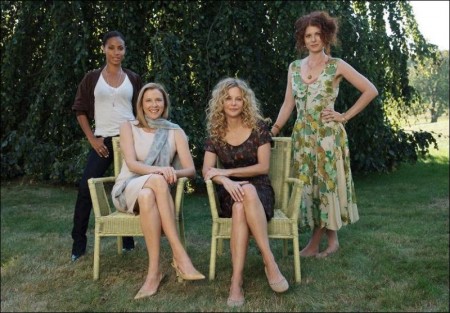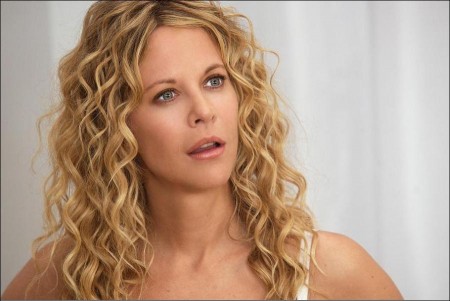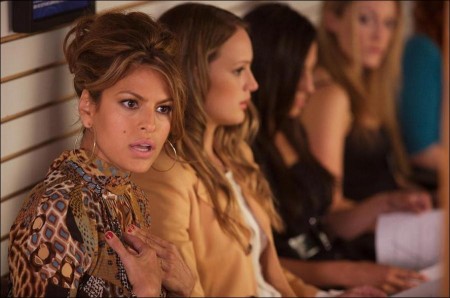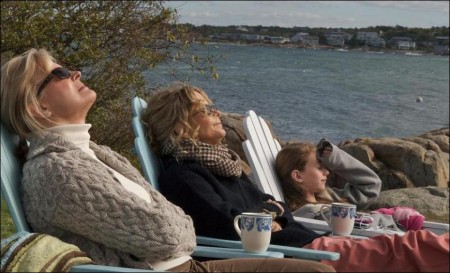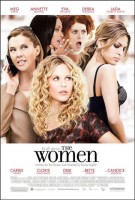Tagline: It’s all about…
Mary Haines (Meg Ryan) appears to have a perfect life: a beautiful home in Connecticut, a lovely 12-year old daughter, a successful Wall Street honcho husband, and a part-time career as a designer for her father’s clothing company. Mary not only seems to have it all, she seems to do it all: whether it’s planting perennials in the garden; following in her mother’s footsteps as co-chair of a Central Park women’s committee; or personally doing the cooking for a benefit luncheon, despite having the full-time help of her beloved housekeeper Maggie, (Cloris Leachman) and a nanny, Uta. If she’s a little frazzled at times, who can blame her?
One thing Mary can always count on is the wonderful company of her girlfriends, like her best pal, style maven Sylvie Fowler (Annette Bening). A woman of impeccable chic and rapier wit, Sylvie is happily single and at the top of her field as the newly-installed editor of the venerable women’s magazine CACHET. Mary and Sylvie’s close-knit circle also includes Edie Cohen (Debra Messing), an eccentric mother-hen to her girlfriends as well as her ever-expanding brood of children. And then there’s humor essayist Alex Fisher (Jada Pinkett Smith), a glamorous ladies’ lady with her own special gift for telling people the last thing they want to hear.
But for these longtime friends, all hell is about to break loose. The trouble starts at in the Beauty Salon at Saks Fifth Avenue, of all places, where Sylvie sits down with the hot new manicurist in town, Tanya (Debi Mazar). Within moments, chatty Tanya is spilling the beans about the store’s resident gold-digger, a perfume “spritzer girl” named Crystal Allen (Eva Mendes) who has landed one very big, married fish: a Wall Street tycoon named Stephen Haines. The anguished Sylvie finds herself in a dilemma, one that soon spreads to her girlfriends: what, if anything, to tell Mary? But before the friends can come to an agreement, Mary ends up getting a manicure at Saks. From Tanya.
Mary’s female comrades close ranks around her, each offering strong opinions about what she should do. Ultimately, Mary decides to heed the advice of her mother Catherine (Candice Bergen), an irreverent parent who has grappled with any number of life issues, from straying husbands to aging. Together, Mary, Catherine and Mary’s daughter Molly (India Ennenga) take an all-girl break at Catherine’s summer cottage in Maine.
Meanwhile, Sylvie is having her own troubles at work, where her efforts to remake CACHET have yet to yield much success. With her dream job in danger, Sylvie tries to recruit famed gossip columnist Bailey Smith (Carrie Fisher) to write for the magazine. But Bailey – who is penning an exposé of Wall Street marriages — drives a hard bargain, with a nasty price: Mary’s privacy. Backed into a corner, Sylvie chooses career over her best friend.
For Mary, Sylvie’s betrayal is the cruelest blow of all. She cuts Sylvie out of her life and embarks on an extended period of soul-searching, with detours for sloppiness and sugar. Eventually, she lands at a women’s health camp high in the Berkshires, where she meets Leah “The Countess” Miller (Bette Midler), a flamboyant, reefer-loving Hollywood agent, whose buoyantly pragmatic philosophy proves inspirational.
Returning to New York, Mary begins to reconnect with the woman she has always been, but lost sight of in trying to be all things to all people. She finds a fresh clarity about what, and who, matters most to her in this world. That understanding will prove crucial on the day she comes face to face with the person who hurt her most deeply, but whose absence she feels most keenly: Sylvie.
And so it is with a new sense of certainty that Mary Haines strides forward into her new life. She knows what she wants, and with a little help from all the women in her life, she’s going to get it, too.
About the Production
In 1994 Diane English, the award-winning creator / writer / producer of the landmark sitcom “Murphy Brown,” read an article in Variety about a potential remake of The Women, the classic 1939 comedy directed by George Cukor at MGM. Based on the hit 1936 play by Clare Booth Luce, the film told the story of a wronged society wife and her circle of friends. It boasted an all-female cast of stars, including Norma Shearer, Joan Crawford, Rosalind Russell, Paulette Goddard and Joan Fontaine.
The article piqued her interest and got her thinking. “I remembered the old movie and how exciting it was to see all those great actresses up on the screen together. And how fun it was that there was not a man in sight,” English remarks. “But I also remembered that the movie had very old-fashioned ideas that were in great need of updating.”
The film and play were very much products of their era, when women were expected to pursue marriage first and foremost. More specifically, the original works focused on a particular milieu – Manhattan high society – which Luce first skewered as a writer/editor at the magazine Vanity Fair. Luce, who married powerful Time magazine publisher Henry Luce in 1935, had a field day with Gotham’s leisure set with “The Women,” her second play. The film’s screenplay, by Anita Loos (the novel “Gentlemen Prefer Blondes”) and Jane Murfin, maintained Luce’s acerbic perspective.
“The original play and film were written as a poison pen letter to shallow society women who would stab each other in the back over a man,” says English. “It was catty and incredibly fast paced and had a real rapier wit. I had to figure out a way to shift the focus. I wanted to celebrate women, but still try to preserve the hallmarks of the original, which included the biting wit.”
Her strategy was to keep the underlying story, about Mary Haines, a happily married woman who discovers her husband is having an affair with a salesgirl named Crystal Allen. But she broadened the spectrum of women who comprise Mary’s circle of friends and family, creating characters of different backgrounds, generations, professions, marital status and sexual orientation. Mary herself is a very recognizable contemporary woman; bright and accomplished but also over-extended, with a part-time career in fashion, a prominent role in charity committees, and a strong inclination to try to please everyone. Edith Potter, a mother of six who pretends to dislike gossip, became Edie Cohen, a nurturing, artistically inclined mother of four. The original film’s sole bachelorette, the sardonic plain-Jane writer Nancy Blake became Alex Fisher, an acclaimed humor essayist and sexy lesbian playgirl.
Perhaps most critically, English re-invented the character of Sylvia Fowler, Mary Haines’ best friend. As portrayed by Rosalind Russell in the Cukor film, Sylvia was a catty society wife with a penchant for collecting and spreading gossip. English transformed Sylvia into Sylvie Fowler, a happily single top magazine editor who has been Mary’s devoted best friend since college. In the original, Sylvia gleefully stirs the pot of Mary’s troubles; in English’s telling, Sylvie’s betrayal of Mary’s privacy is part of a Faustian bargain she makes reluctantly and regrets profoundly.
In describing her approach, English explains, “I wanted to turn the film into a love story between two straight women. The original is all about whether Mary Haines will reconcile with her husband, who betrayed her trust. In my version, I want the audience to care more about whether Mary Haines will reconcile with her best friend Sylvie Fowler, who also betrayed her trust.”
But there was one original aspect of the film and play that English wouldn’t touch: there would not be a single man onscreen. That became a stumbling block as English sought to bring her script to the screen.
Says English, “It was difficult to get this film made because it’s an all-female cast and today movies don’t really serve the female audience. The movie business caters to young men who have demonstrated their willingness to go to the movies in large numbers, often seeing a film over and over. Once in a while there’s a SEX AND THE CITY and everyone sits up in shock and says, `Wow, women actually will go to the theatres in large numbers!’ And then they forget very quickly and we have to start all over again. So it became a personal mission of mine to try to change that way of thinking.”
That determination finally paid off in 2003, when English hosted an all-girl get-together — a viewing party for the television series “Sex and the City,” as it happens – at her home in Martha’s Vineyard. One of the guests was producer Victoria Pearman, who came with a mutual friend. Pearman was a fan of English’s work, and knew that she had written an updated version of THE WOMEN, which had yet to make it into production. “It was such a good project and I couldn’t understand why it had stalled,” the producer recalls. At Pearman’s request, English gave her a copy of the script. “I read it and fell in love with it,” reports Pearman. “I asked Diane, `Is there anything I can do to help?’ And she said, `Well, what are your ideas?’ I told her a couple of ideas about financing, what I would’ve done. She said, `Well, would you do it?’ And I said, `Sure,’ just as a girlfriend. And then she says, `No, no, I mean, officially — would you come on board as a producer?’”
Pearman and Mick Jagger formed Jagged Films several years earlier and made the Rolling Stones / Martin Scorsese film SHINE A LIGHT for Paramount in the same year as THE WOMEN. “Mick was incredibly enthusiastic about THE WOMEN”, says Pearman, “and completely got behind the project.” With Jagger’s blessing, Pearman took the script to financiers and international sales company, Inferno who were equally enthralled and the partners, Bill Johnson and Jim Seibel, came on as producer and executive producer, respectively. “That summer,” says Pearman, “I was at my home in Martha’s Vineyard, and I shamelessly pitched the project to Bob Berney of Picturehouse who was visiting the island for a mutual friend’s birthday party. He loved the idea.”
After meeting with Diane English back in Los Angeles, Berney agreed to distribute the film. “It was very serendipitous,” added Pearman, “as New Line was then the parent company of Picturehouse, so it made perfect sense and we were able to keep the film in the Time Warner family. We had the blessing of Bob Shaye and Michael Lynne, the founders of New Line. Carolyn Blackwood at New Line was instrumental in getting the project up and running with so many complicated elements and multiple partners. We could not have done all this without her and the complete support of Jeff Berg and Hal Sadoff at ICM, who were instrumental in making an unprecedented deal with Dove to be co-financiers of the film, promoting their “Campaign for Real Beauty”. Now the next phase could get underway: casting.
In the mid-1990s, there had been a period of momentum for English’s version of THE WOMEN and different actresses had been in discussions about leading roles. Among them was Meg Ryan, whose unique ability to shift easily from comedy to drama made her a natural choice for the complex role of Mary Haines. More than a decade after those initial talks, Ryan reaffirmed her commitment to THE WOMEN. The actress appreciated English’s take on the film as a love story between two straight women, Mary and her best friend, Sylvie. “This movie is about what happens when girlfriends break up,” Ryan observes. “It’s sometimes a lot worse than when a male-female relationship breaks up. I thought it was interesting to make a movie about that.”
Annette Bening was cast as Sylvie Fowler, the other partner in the film’s central love story. The combination of English’s screenplay, the subject matter and the chance to work with Ryan made THE WOMEN too good to pass up.
Says Bening, “I thought Diane’s script was very funny and smart and insightful about women: a really good piece of entertainment. I knew that Meg Ryan was going to be doing it, and I liked the character, Sylvie, who’s a businesswoman and a real wise-cracker. I’ve never done a film quite like this, and I just relished the idea. It is definitely a comedy, but it’s really about something very deep, which is how women connect to each other and take care of each other.”
Eva Mendes was cast as Crystal Allen, the slithery shopgirl who gets her hooks into Mary’s never-seen husband. Mendes admits to some initial trepidation about immersing herself in Crystal’s cut-throat skin. “Crystal’s exactly the kind of woman that I’m scared of; she uses everything she has to get what she wants,” Mendes remarks. “At first it was a little hard getting into her. And then Annette said, `Have fun, just go for it.’ I thought, `Yeah, that’s right.’ Crystal’s just doing what she thinks she needs to do to survive. After that, I had a lot of fun with Crystal and fell completely in love with her.”
Debra Messing portrays Edie Cohen, a doting mother forever in search of the perfect creative outlet. When Edie is first introduced, she’s busy playing with her little girls – and Messing brought something of herself to the part. “I have a clown nose that I brought in to show Diane,” the actress recalls. “I said, `I knew you wouldn’t believe me that I actually had one. But I have one and my son has one. And we walk around the apartment in New York City with our matching clown noses on.’ Diane loved it, and it ended up in the film.”
Jada Pinkett Smith took on the role of Alex Fisher, the acerbic, highly opinionated writer who finds herself at loss for words during the film’s antic climax. “Alex has this real tough exterior but when things get down to what I’d call `the real deal,’ she completely loses her cool. She becomes this big `ol softie,” says Pinkett Smith. Like her co-stars, the actress was eager to be part of a film that was all about women, and made by women. “I met Diane and Victoria and just fell in love with them. I want to support female directors and women who want to direct; there needs to be more of us behind the scenes. Diane had wonderful vision, a stellar cast, and it was THE WOMEN. I was like, `Absolutely! I’ll be a part of this.’”
A dazzling roster of comic actresses joined the ensemble in supporting roles. Cloris Leachman plays Mary’s no-nonsense housekeeper Maggie, who tries (in vain) to remain emotionally detached during her employer’s time of crisis. Carrie Fisher portrays Bailey Smith, a merciless gossip columnist who manipulates Sylvie into betraying her best friend. Bette Midler plays the Hollywood mega-agent Leah “The Countess” Miller, a woman of many marriages and no regrets. Debi Mazar plays chatty Saks Fifth Avenue manicurist Tanya, who opens a world of trouble when she begins gossiping about her co-worker Crystal.
Mazar had auditioned for the role of Tanya back in 1995; she was delighted when English phoned her over a decade later. “Diane English offered me the part of the manicurist after all those years,” the actresses marvels. “I had morphed two times with pregnancy, but she had faith in me.” Mazar’s character has become a beauty celebrity thanks to her custom colors and a big fan named Madonna. In real life, Mazar and Madonna have been good friends since the singer came to Manhattan as a young unknown. Tanya’s connection to Madonna came as a surprise to Mazar, one she loved. “For me to play Tanya and talk like a young Madonna fan was funny and fantastic,” she enthuses. “I got to channel all the gals I knew who were like Tanya – who I always hooked up Madonna concert tickets for the past two decades!”
There was another actress who pledged her support to English and THE WOMEN from the beginning: Candice Bergen, who starred in English’s “Murphy Brown” for its 10-year run. Bergen dispenses copious wit and irreverent wisdom as Catherine Frazier, Mary Haines’ mother. In a felicitous bit of symmetry, Bergen played Ryan’s mother in Rich and Famous, the final film from George Cukor, director of 1939’s THE WOMEN. Says Bergen, “It was Meg’s first job. She said she was terrified, but of course at the time who knew? And Meg’s wonderful to work with, so alive and so detailed.”
Bergen applauds English for creating a film that retains the spark of the original while speaking to contemporary audiences. Says Bergen, “I had very high expectations, since it’s Diane. Because it is an issue: is the story still relevant so many years later? And, the way it’s written, it is. She’s done a wonderful job of adapting THE WOMEN to the present.”
Assembling the cast for THE WOMEN was not a quick process, given the intricacies of the actresses’ personal and professional schedules. But it could not have worked out better, affirms English. “I couldn’t be more thrilled with this cast. Meg was with it from the beginning. Annette was dream casting to step into the Roz Russell part. Eva really had some big Manolos to fill, in that she took the Joan Crawford part. The great thing there is that she is so funny, you can’t fully hate her. As far as comic timing, there is no one like Debra Messing. An ensemble always needs that kind of comic glue. Jada will make everyone say, `Why isn’t she doing more comedy?!’ She is so funny in this. Candice, of course, is my muse. I told her I could not make the film without her in it. Cloris nearly steals the movie at age 82. Debi Mazar auditioned for her part ten years ago and ten years later gets the call! Carrie has a great cameo as a gossip columnist and plays her entire scene on an elliptical trainer. And Bette is just the icing on everyone’s cake. Audiences start giggling the minute she comes on screen.”
THE WOMEN also features two talented young actresses as members of the Haines’ household: young India Ennenga portrays Ryan’s daughter, Molly, a bright girl about to enter the minefield of her teens; and Danish actress Tilly Scott Pederson plays the Haines’ nanny, Uta, who is enthralled by supermarket tabloids. Rounding out the ensemble in small but critical roles are esteemed veterans Joanna Gleason as a society matron, and Lynn Whitfield as a Saks Fifth Avenue fashion buyer.
Prior to the start of production last summer, English gathered her primary cast – Ryan, Bening, Mendes, Pinkett Smith and Messing – at her home for five days of rehearsals and simple hanging out. “I wanted the cast to appear onscreen as if they had known each other forever. I wanted that interaction to ring true, to be authentic. By the end of those five days we had really spilled all of our personal stories, and formed lifelong bonds. We read the script aloud the first day and then just let it settle in while we all went shopping. Then we attacked it the following day, going scene by scene, discussing the intention, throwing in our two cents, improvising some things. I did my final rewrite based on that rehearsal period. So by the time we got on set and faced our incredibly short shooting schedule, everyone was prepared. Everyone knew their characters, was invested and knew what they had to do. It was great.”
THE WOMEN began production on August 19, 2007 in Boston, and filmed for 36 days in Massachusetts and New York City. The behind-the-camera team included the gifted director of photography Anastas Michos, ASC (Mona Lisa Smile), who hired a largely female crew; production designer Jane Musky (Hitch), editor Tia Nolan (Bewitched), and costume designer John Dunn (I’m Not There).
An atmosphere of calm and camaraderie prevailed, recalls Pinkett Smith. “There was communication without a lot of words because we’re all women; we’re married, we have children. It was a really nurturing environment; we’d be on the set and in the make-up trailers, telling stories about our husbands and our kids. It was a lot of fun.”
In part the relaxed tone was set by English, who earned the nickname “Unflappable.” English credits the intensive rigors of television production with giving her solid footing for her first feature. “Running a half hour television comedy is a real test of endurance; you have to write scripts, give direction, cut last week’s episode and plan next week’s, all at the same time,” she notes. “And if you’re successful, the show goes on for ten years and there’s no let-up. So it was really fantastic preparation. It’s all about decision-making and having confidence in those decisions. Or the confidence to say, I don’t know, I need some help. That’s probably the most important thing.”
Leachman, who has worked with directors including Mel Brooks, Peter Bogdanovich and James L. Brooks, praises English for her skill and equanimity. “Diane was exceptional. Just the most gentle, easy person,” says Leachman. “I had great fun making the film. The first scene I did, there were about six of us; just to stand there with these extraordinary actresses – and they’re extraordinary women – was tremendous. And we worked very hard; we wanted it to be wonderful, because Diane gave us such wonderful material.”
Fans of the original film will find certain beloved touchstones intact, including a talismanic nail varnish, a dressing room confrontation, and a glamorous fashion show, in this case attired by celebrated designer Narciso Rodriguez, with custom shoes by Manolo Blahnik. “Fans of the original will definitely recognize some major set pieces,” promises English, noting that her film is upfront about its focus. “The old movie’s tagline is `It’s all about men!’. Ours is, `It’s all about the women.'”
It’s an emphasis that Mendes welcomes. “I love men and God bless men, but I think that nothing can replace that female bond,” the actress says. “I have the same friends I’ve had since I was 12, 13 years old and we’ve gone through everything together. And that is invaluable.”
Production notes provided by Picturehouse.
The Women
Starring: Meg Ryan, Annette Bening, Eva Mendes, Jada Pinkett Smith, Debra Messing, Candice Bergen, Bette Midler, Cloris Leachman, Carrie Fisher
Directed by: Diane English
Screenplay by: Diane English
Release: September 12, 2008
MPAA Rating: PG-13 for sex-related material, language, some drug use.
Studio: Picturehouse
Box Office Totals
Domestic: $26,839,020 (68.0%)
Foreign: $12,608,260 (32.0%)
Total: $39,447,280 (Worldwide)
